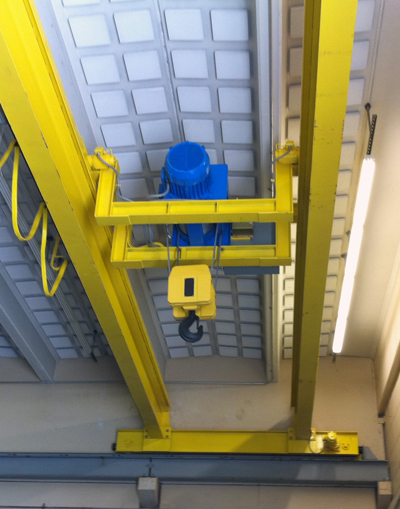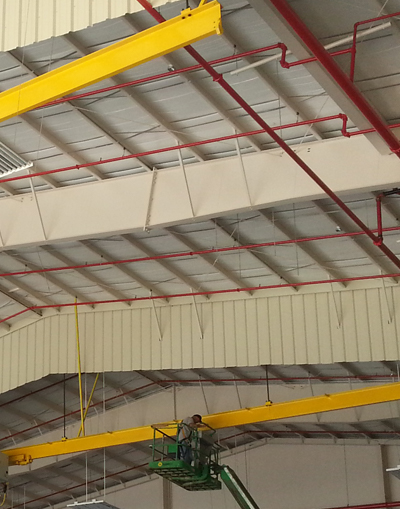Overhead Bridge Crane
Material Handling Systems has been designing, manufacturing, and installing overhead cranes for over 35 years.
An Overhead Bridge Crane is composed of an assembled structure that extends between runway tracks, and is capable of carrying a suspended load horizontally along the runway. Overhead Bridge Cranes can be top running or under-hung with single or double girder configurations. To move the load laterally as well as vertically, Overhead Bridge Cranes incorporate hoists and trolleys. These types of cranes can be push, geared or motorized.


Double Girder
Top Running - Up to 20 ton capacity, Up to 120 feet span
Under Running - Up to 15 ton capacity, Up to 200 feet span (Multi-Runway Cranes)


Single Girder
Top Running - Up to 20-ton capacity, Up to 120 feet span
Under Running - Up to 20-ton capacity, Up to 120 feet span
What to look for in a crane quote
Although all cranes may seem the same when you read quotes, we believe that an MHS crane stands out.
The following is a list of standard items on an MHS crane that may not be standard on other brands.With MHS you get the resources of a large company along with the individual care and concern of the small company next door.
All of our control boxes are UL508A certified approved and labeled. Although most companies use UL components, they do not certify the entire control box. Many localities (and we are told eventually all) have changed their code to require the control box bear a UL508A or other approved label on the front. Most customers do not find this out until it is too late. Field certification can cost tens of thousands of dollars.
Other companies use SO or tray cable to bring power to the end truck motors to save cost. (most systems with plug in connectors do not meet the National Electric Code) Although they may tell you different this is a violation of the National Electric Code – 610-11 – Conductors SHALL be enclosed raceways (raceways are defined as “an enclosed channel designed expressly for holding wires…”) or be metal clad cable (AC, MC, of MI) with the exception of festooning, Short lengths to collectors, or pendant cable.
MHS wheels are hardened to 380 – 420 Brunel. Other companies use cast wheels that are much softer. Cast wheels typically last 1/2 to 1/3 as long as hardened steel wheels and can cost over $10,000 to replace. Hardened steel wheels typically last well over 20 years.
Standard on trolleys and bridge. Although required on all cranes and on some hoists many companies do not provide as standard
We believe we have the best technicians and installers in the world. Every person on our team is trained to never replace a part unless you know why it failed.
MHS offers a 3 year warranty. In many cases at no cost. We can do this because we design and build in quality and durability.
This assures straight and parallel runways reducing wheel wear. We recently replaced 4 cranes and realigned runways at a cost of over $150,000 (cranes were less than 10 years old). The customer saved a few thousand dollars on the original installation. Obviously no company is going to admit they do not properly align runways. Check with our regular customers on our quality -Rolls Royce (Florida and Washington) Gradau Steel (Peru, Florida and Georgia) and many others throughout the world. They have found the quality of our product, service, and installation. MHS has averaged almost 20% annual growth over 15 years mostly thru word of mouth.
Flat cable is specifically designed for festooning. Other companies save costs by using round cable or running individual wires in a nylon cover. NOTE: The covers we have seen are not UL approved.
Our engineering department can solve your problems. We have designed such things as a New year ball lowering systems to special carts that move cooling chambers at nuclear power plants. We have upgraded capacities systems cost effectively (in one case from 10 to 30 ton without changing the runways or footers) and built specialty very low headroom cranes (in one case 10″ headroom on a 8 ton 40 foot crane)
MHS offers lease options. A 5 year lease with a $1.00 buyout at the end costs as little as 2% of the cranes price per month. In many cases your payment will be less than half of your monthly labor savings.
Although a brake or other non coasting mechanism is required many companies do not provide as standard. Brakes are standard on MHS cranes.
We do not use quick disconnects. Other companies have spun quick disconnects into a plus. There are several reasons this is not true:
- 1. Each disconnect is a potential failure point. Sales personnel will tell you these rarely fail. The government spends several hundred per connector to reduce failure rate. The connectors used on cranes only cost several dollars. If they were so reliable why would people spend several hundred dollars when failure matters.
- 2. Although the broken disconnect is easier to install than a wire without a disconnect the wire assembly must be purchased. This assembly is more costly and must come from the manufacturer. Your system may be down while you wait for parts from the factory.
Branch fusing is a National Electric Code requirement. Our cranes all have separate fusing for the bridge, hoist, and trolley. Many cranes have either a single set of fuses or two sets, one for the bridge and one for the hoist and trolley.
We use angle welded to the crane to support our festoon. Many companies use bolted track. Although easier to install and less costly we have seen this bent in several instances due to pendant weight.
The NEC requires fusing on the input of transformers. MHS fuses both input and output to protect the line and the transformer
Hook bolts allow for proper alignment of runways. Manufacturer calls for splice plates on all rail joints. Although required by manufacturer we have seen many systems without splice plates at joints and seen several systems with the rail welded to the runway beam (rail is high carbon steel and cannot be welded with standard welding rod).
In order to operate a crane safely the operator must know how to properly use the crane. We provide operator training with each crane to assure your operators know how to safely and efficiently operate your new crane and to comply with OSHA requirements.
All our cranes are painted with marine grade epoxy. Epoxy is a stronger, and much more costly, paint. We do this because we are proud of our cranes and want to provide a product that will look good for decades.
All of our cranes come with durable C track festooning. Our festoon trolleys have metal roller bearings for long life, not plastic wheels or bushings.
The columns used on systems supported from the floor are several times larger than required for loading. We realize that forklifts occasionally run into columns and we oversize our columns to withstand all but the worst of these collisions.
